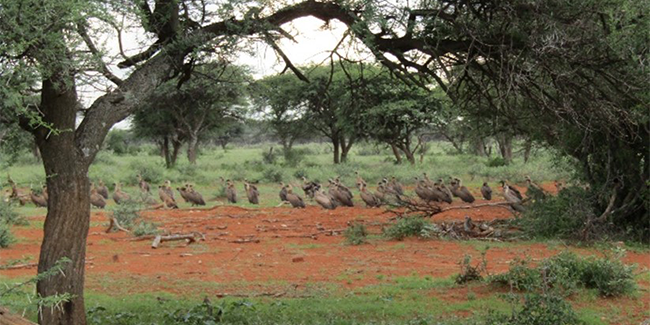Two rehabilitated Vultures released by the Birds of Prey Programme in Mokala National Park
By Ronelle Visagie, Birds of Prey Programme.

Neska on the day she was confiscated (13 January 2024) and a week later.
In December 2023, I fetched an injured White-backed Vulture from Kimberley Veterinary Clinic. The bird was found somewhere in town and had a broken leg. The bird was in an excellent condition and was eating well. Its leg was pinned by Dr Burger. From the start this vulture was very feisty so we decided to call her “Kwaaitjie” (bad girl).
Once home we put her in a deep crate as the orders from the vet were to keep her still. Two days later she was able to sit on the side of the crate and was ready to jump down so we moved her to a small aviary where she could be on the ground and still not move too much. Kwaaitjie must have decided it was too boring for her to be confined and not move around too much, so she took it upon herself to remove the pin from her leg – only eight days since the operation.
Because of this I contacted the Kimberley Vet Clinic and explained the situation. Following a discussion, it was agreed that Kwaaitjie be left where she is as the risk of injury was too big if we transported or handled her. I had also promised to take her to the Clinic if something happened to her leg.
An X-Ray of her leg two weeks later showed she was on the mend. After being kept in a small enclosure for another two weeks, she was moved to the large aviary where she started to fly.
Barely a month later, in January 2024, I fetched a Cape Griffon from the Kimberley Veterinary Clinic that had been confiscated by police in a township near the Northern Cape town. The police had taken the bird to Dronfield to be released. It was then that Aneska Almendro, working for De Beers at Dronfield, saw that the bird needed veterinary care and took her to the Clinic. The Griffon was in a severely stressed condition, and the vets had to put her on at least two drips to save her life.

Part of a large group of vultures at the waterpoint.

Neska on the day she was confiscated (13 January 2024) and a week later.
After collecting her, I put the Griffon, which we had named Neska, in a large aviary so that she could walk and stretch her wings. But, she refused to move for the first two days. This might be because of the way she was treated before she was confiscated. It was exciting to see her finally start walking around and stretching her wings. She was also eating well after her ordeal.
Both vultures recovered very well prompting our decision to release them back into the wild as soon as possible. Kwaaitjie and Neska were ringed before being transported to their new home — Mokala National Park.
On our arrival at the watering hole where vultures usually bath and drink, we were met by more than 100 of raptors at the water and in the trees. Most of them were White-backed Vultures and at least three Cape Griffons were also seen.
When we opened the transport crates, the two birds walked out, stood for a few minutes to take in their new surrounds and took flight.
** We would like to appeal to members of the public not to keep Birds of Prey as pets. If you see an injured or poisoned bird, call your nearest veterinarian so they can receive the treatment needed.
